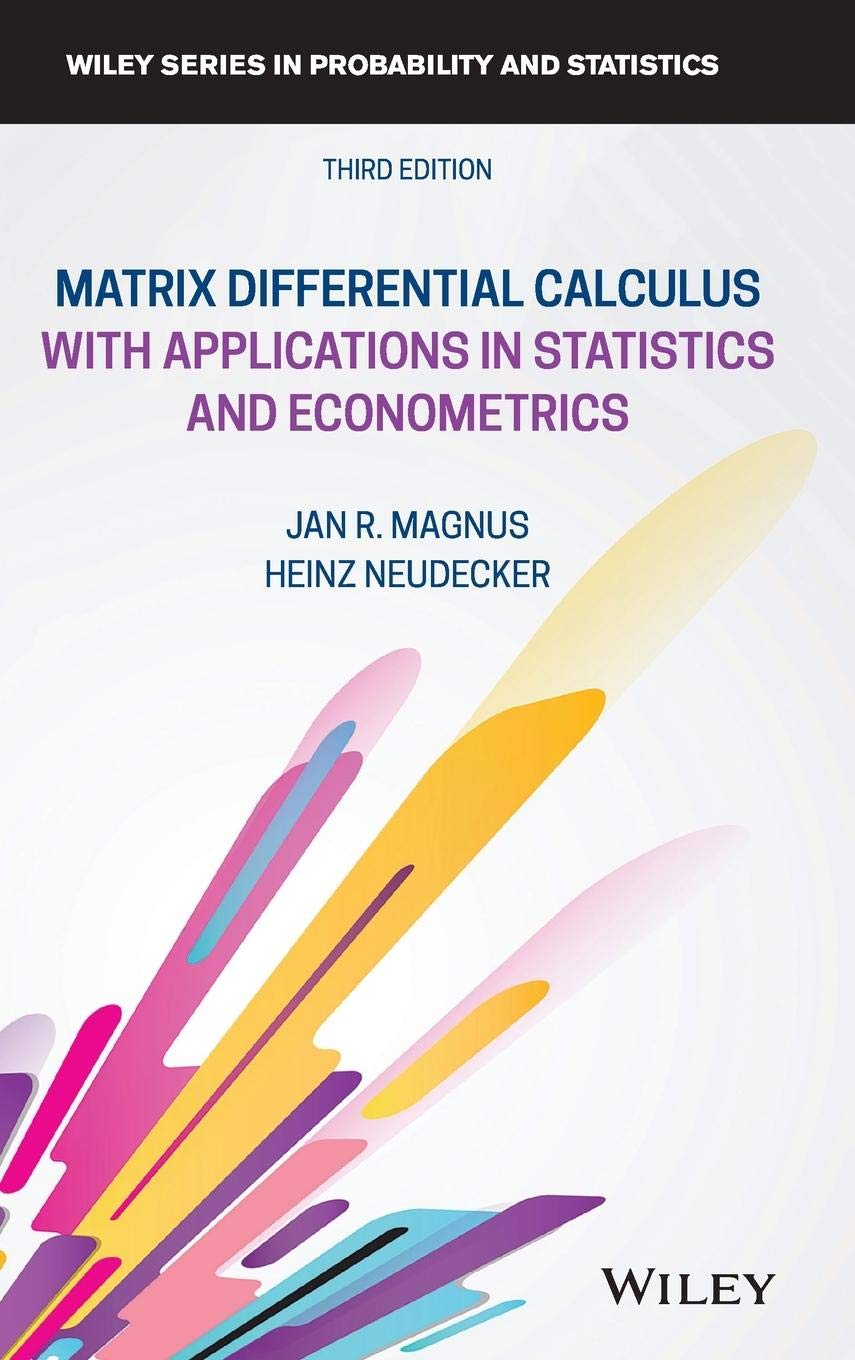

Matrix Differential Calculus with Applications in Statistics and Econometrics (Wiley Series in Probability and Statistics)
A**R
Essential
This book comprehensively covered the theory and implementation if matrix differentiation. However, the theory may be a little much for those approaching from a more practical standpoint.The chapters on psychometrics and instrumental models weren’t stellar in my opinion.
T**S
Good content with bad presentation
I purchased it to prepare myself in order to take a PhD selection exam in Economics. The content is superb, unfortunately the type isn't good.
B**R
Fantastic Book, but Where is the 3rd Edition
The paperback is the 2nd Edition and the hardback the 1st Edition. There's a 3rd Edition available in electronic form. It was completely re-typeset.The mathematical writing in this book is truly beautiful. And I have no complaints about the new typesetting.There's a crystal-clear, just-the-facts review of matrices, linear algebra, the basics of metric topology for R^N, convexity, and differential calculus. They have beautiful, easy-to-follow proofs of the key theorems. The approach is very (abstract) algebraic and (metric) topological, which I like. They take a Taylor-series-based approach to differential calculus that's very enlightening, arguing for the primacy of differentials over derivatives (which lines up with what I'm seeing in statistical physics books like Leimkuhler and Reich's book on Hamiltonian simulation). Overall, the introductory material was perfect for someone like me who needed to brush up on my continuous math for statistics and optimization after 25 years focusing on discrete math in computer science.The book really picks up after the basics, going into derivatives of simple matrix operations and pretty quickly ramping up to matrix operations like eigenvalues. I haven't even gotten to the optimization and statistics part of the book yet. The latter is mostly in a frequentist, maximum-likelihood setting, which fits in with the chapters on optimization.
U**O
enormous utility
For some reason, in spite of its enormous utility, matrix differential calculus is oddly absent from standard courses in signal processing and control. The great strength of this text is its focus on the development of sufficient and necessary conditions for constrained/unconstrained minima/maxima. There are good examples regarding maximum likelihood estimation. There are also some useful results regarding the Kronecker product and commutator matrices. The chapter at the end covers specific topics in econometrics. The paperback edition suffers from completely hideous typesetting that is exacerbated by some of the notation. In spite of the fact that the paperback is not cheap, the pages look like they were photocopied. Maybe I just got a bad copy. I don't know if the hardback edition has the same problem.
S**V
essential guide to matrix calculus
I am unusually lucky to get around the typesetting problems described by other reviewers: I was translating the book into Russian a few years ago based on the authors' LaTeX files, so I am not even sure I saw the Wiley book printed. I also was able to receive the author copy from the Russian publisher for free. Of course Wiley's price of $300 is ridiculous! The authors complained about it, too, seeing this as an objective obstacle for dissemination, but there is little they could do about the price.I have not appreciated the book that much until I hit the need for matrix calculus for my dissertation research. Knowing the book fairly closely, I was able to find the results I needed in 15 minutes, and applying them to my problem provided a huge leap in the generality of results, as well as shortened the derivations from about 15 pages of ugly element by element computations to about three pages. Two thumbs up!The book also contains a wealth of important mathematical results and makes the reader think rigorously about their notation (which is important for both matrix computations and for caclulus, thus making it at least twice as important in matrix calculus), so it can be targeted not only at statistical and econometric audiences, but can also serve as a useful supplement to a linear algebra course.
I**A
Too bad!
I was surprised to learn about the poor quality of typesetting in the paperback (second?) edition. I reviewed the book for JASA, when it first appeared, and, over the years, I've used it many many times. It is really a remarkable book, for allof us who need to deal with matrices in our everyday research work.I was about to buy a second copy of the book, but the hardcover rice is ridiculous (more than $300!!), and I was turned away from buying the paperback edition because of the comments on the bad quality of typesetting.This is too bad. A book of this stature deserves a better treatment by the publisher!
M**G
Bad typesetting reviews are not exaggerating
I have read the bad reviews regarding the typesetting of this book and I thought they were exaggerating. Nevertheless, I have borrowed this book (old edition/hardcover) from the University library and I thought that buying it was worthwile.When I ordered the book I found out that the book quality was even worse than expected. The typesetting is worse than a photocopied book; I even thought that this was not an authentic copy but a cheap one from a Banana country. Nevertheless, when you open to read the book pages are coming out. The hardcover edition price -$300$- is ridiculous. I am a postoctoral fellow in engineering and I cannot afford more than $100 for a book. The $80 dollar price is not justified for that bad typesetting. This is a very helpful book for a graduate engineering student but I doubt that I will recommend it for buying. I will have to think seriously about buying another book from Wiley piblishers.
A**様
勉強中
ハードカバーとKindle版を一緒に購入しました。定理の証明はかなり端折っています。
Trustpilot
2 weeks ago
3 weeks ago